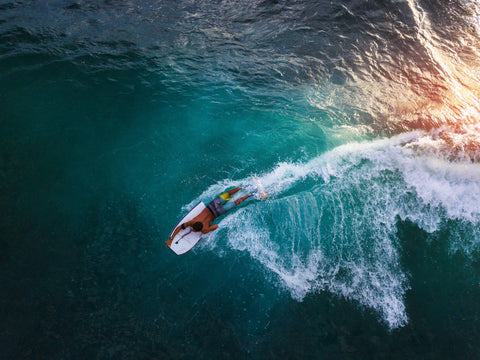
Morey Mach 7 42" Bodyboard
Morey
THE BASICS If you're looking for the perfect mid-range bodyboard, look no further. Built by Morey (the company that invented the boogie board in t...
View full detailsNow that you've got a solid board and solid leash, it's time to move on to fins.
Some of you may think, "Well, do I really need fins?" The answer to that question is simple: if you want to catch more waves, you'll want fins.

Imagine yourself out there on a really nice day.
The waves are coming at you fast, and you're trying to catch one.
You keep trying to catch them, and you're getting a few, but losing a lot more due to not being able to paddle to them fast enough.
Or maybe you're catching some and not able to ride through the whole wave because you can't paddle through quickly enough.
Fins are the solution to this problem. They'll allow you to paddle quickly, react quickly, and give you the propulsion and boost that you need to catch more waves.

While you can bodyboard without fins, it's close to surfing without arms -- essentially, when bodyboarding, you're using your legs to propel yourself and catch waves.
This is unlike surfing, where you're using your arms to paddle in and catch as many waves as possible.
You want to get into the wave as quickly as possible - this not only will allow you to catch it, of course, but also enjoy a longer ride.
Now, of course, there may be a few reasons why you may not actually want fins, which we'll dive into now.
If you're an advanced or pro-level boarder, fins are definitely a must for medium and large waves.
For smaller waves, it's up to personal preference - it may be worth it to get a pair of fins just to catch some extra waves and for ease of paddling.
If you're a newbie, it's fine to wait, however, if you're set on catching more waves, or want to learn how to use fins properly, it's worth picking up a pair. Fins are relatively cheap in comparison to the performance boost you get.
Last but not least, if you're trying out different ride styles, such as stand up bodyboarding, or drop knee bodyboarding, fins may not be the right choice when starting out.

It's important that you choose a fin type that's comfortable for you. There's a lot of different factors that go into choosing the perfect fin type, which we'll dive into below.
Size is the most important factor. When you're bodyboarding for hours, you will really notice the difference between a good and bad pair of fins. As such, choosing a fin size that's a perfect fit for you is extremely important.
To know your fin size, simply measure your shoe. Your fin size will likely correspond to your shoe size.
Each fin brand has a different way of measurement - some brands will have three or four sizes, each being a range of shoe sizes. Churchill is one of the most popular brands that does this.

|
Medium | ML | Large |
| Mens | 7-8.5 US | 9-10.5 US | 11-12.5 US |
| Women's | 8.5-10 US | 11-12 US | 12.5-14 US |
Other brands will have more specific fins tailored to your shoe size or even custom fits. You can check out swim fin sizing for other popular swim fin models here.
When trying on a fin, you'll want to make sure that your toes are close to the pocket, but not touching the pocket. You don't want your toes to rub up against it, but you want them close enough to be snug.
On the back end of the fin, you want it to be snug with your foot, at the same time without being too tight.
The top of the fin shouldn't press too hard on the top of your foot. You'll want some up and down movement. Once again, enough to be snug, but not too tight.
If you're wearing thick fin socks or booties (5mm+), add around 3-4 shoe sizes and test accordingly.
If you're wearing 2mm-4mm fin socks or booties, add at least 1 shoe size and test accordingly.
In other words, you want your foot to be comfortable inside the fin without much movement. Fins are a bit tighter than shoes, but they shouldn't be uncomfortably tight.
On the other hand, too much movement will cause cramps and rubbing, which is extremely uncomfortable in longer sessions.
We always recommend trying on a few pairs of fins or talking to us prior to an order, as some fin sizes run larger or smaller than advertised. That way, you know you'll get a perfect fit.
Another factor to take into consideration is if the fins float.
We always recommend looking for a pair of fins that float, as in the slight chance that one falls off, you won't have to go purchase another pair.
Luckily, lots of mid- to high-end fins do float!
You'll want to look into what fin brand is best for your specific foot type. Much like shoes, certain fin brands work better with wider feet, narrow feet, etc.
For those with wider feet, Churchill Fins do great.
For those with narrower feet, you'll want to shop around. You can always contact us for more detailed recommendations.
Fin material is another factor to take into consideration when choosing the right pair of fins.
Luckily, most fins are of a similar material: PVC.
Most fins are made of a hard plastic material, mixed with a rubbery insole for your foot.
PVC will make a fine material that will last long if it's higher quality.
PVC fins come in varying stiffness.
Higher stiffness fins will provide you with a quicker response time and more durability at the cost of comfort.
Lower stiffness fins will be comfortable, but will have a lower response time and less durability.
NOTE: Stiffer fins are MUCH harder to swim with! If you aren't an experienced swimmer, start off with fins that are softer.
We recommend trying varying types of stiffness in the waves to determine what you prefer most in your pair of fins, because it can make all the difference!
We recommend buying higher-end fins (generally around $50 or so) as they'll last you quite a few years and they'll be a whole lot more comfortable than a $20 pair of fins.
Durability is another major factor in choosing a good pair of fins.
Are you on a budget? If so, we'd recommend picking up a mid-tier pair of fins. These should cost around $40.
We don't advise using low-quality fins, however. Repeated use of low-quality swimfins can result in some serious repetitive stress injuries, or even cut up your feet due to poor fitting.
If you're a newer bodyboarder and you're looking to invest into a solid pair of fins, spend around $50-60 and pick up a pair of Churchills.
If you're a more advanced bodyboarder, your personal preferences will ultimately determine the best brand for you. There are several types of fins built out for durability, power, propulsion, and comfort. Your ride style will help you choose which of the four factors are most important for you.
If you're solely a bodyboarder, definitely get bodyboarding fins.
Swimming fins are actually different fin types, and work in different ways than bodyboarding fins.
While bodyboarding fins are designed for propulsion, swimming fins aren't going to offer as much of that, as they're designed for different water types and scenarios.
If you like to use fins for bodysurfing, snorkeling, or swimming in the ocean in addition to bodyboarding, however, general purpose fins will work just fine.
Ultimately, most fin shapes will work fine for the novice bodyboarder. If you're a more advanced or pro bodyboarder, shape may become a factor. It all boils down to personal preference.
A newbie should not see much of a difference between fin shapes. As long as they propel you and are comfortable to swim with, you should be all set!
If you're just getting a pair of fins, be sure to pick up a pair of fin tethers as well.
They're super cheap (around $10-15), and they'll help prevent your fins from getting lost.
Once you have a pair, just loop them around your fins and strap them on. Now you're a lot less likely to lose some fins!
Fins are pretty difficult to put on the first time, especially if they're not wet. We recommend dipping them into water or the ocean before putting them on - they'll be a lot easier to slip on once they're wet.
In the unfortunate event that a piece of your fin is broken, you can purchase a resin such as Sponge-Rez. You can learn more about how to use resins such as Sponge-Rez on their site.
As with other surfing and bodyboarding gear, be sure to always rinse your fins when you get back. You don't want the saltwater and sand to slowly degrade your fins over time.
We also recommend leaving your fins in a cool, dry place when not in use. You can check out our guide on swim fin care here.